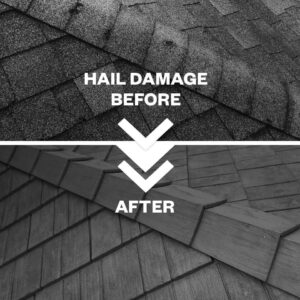The Most Common Types of Roof Damage Homeowners Should Know
Your home is one of your most important investments, and your roof serves as its first line of defense against the elements. However, even the most well-constructed roofs are not immune to damage over time. Being aware of the most common types of roof damage can help you identify issues early and protect your home from expensive repairs and hazards.
This guide outlines the common culprits behind roof damage, offering descriptions, signs to look out for, and actionable tips to address them.
1. Hail Damage

Hailstorms can leave lasting damage on your roof, even if the issues aren’t immediately obvious. Hail can create small dark spots on asphalt shingles and crack or dent other materials, such as metal or cedar shake roofs.
Signs of Hail Damage
- Small dents or scratches on shingles or flashing
- Missing or compromised granules on asphalt shingles
- Broken or cracked shingles
Why it Matters: Compromised shingles lose their ability to protect your roof from UV rays and water. This can lead to leaks and long-term deterioration.
What to Do:
After a hailstorm, inspect your roof from the ground or, better yet, hire a roofing expert for a detailed inspection. Opt for impact-resistant shingles if you’re in a hail-prone area.
2. Wind Damage
Strong winds—and even moderately gusty days—can tear, crack, or lift shingles. Tornadoes or storms intensify the risk, but even normal weather patterns can leave your roof vulnerable.
Signs of Wind Damage
- Missing shingles or noticeable gaps
- Torn or curled shingle edges
- Visible cracks
Why it Matters: Missing or damaged shingles expose the underlying structure of your roof to moisture and further damage.
What to Do:
Regularly inspect your roof for loose or missing shingles. If you notice damage, make repairs promptly rather than waiting for a full roof replacement.
3. Moss and Algae Growth
Moss and algae are more than just unsightly; they can cause structural damage to your roof over time. Moss traps moisture, creating opportunities for degradation and making shingles prone to cracking or warping.
Signs of Moss or Algae Damage
- Green clumps growing on the roof surface
- Shingle corners lifting or cracking
- Water pooling in shaded areas
Why it Matters: This growth can weaken shingle integrity, giving way to leaks and weakening the overall roof structure.
What to Do:
Keep your roof clean and maintain proper drainage by clearing gutters regularly. For areas prone to shade, trim back overhanging branches to reduce moisture buildup.
4. Heat Damage
Persistent sunlight and high temperatures wear down roofing materials, especially those in hotter climates. Heat exposure can cause shingles to warp or develop blisters.
Signs of Heat Damage
- Blistering or bubbling on the shingles’ surface
- Cracked tiles or warping in asphalt shingles
- Shingles curling at the edges
Why it Matters: Heat-damaged shingles may lose granules, compromising protection against UV rays and water damage.
What to Do:
Ensure proper attic ventilation to reduce heat damage. If granules are missing or shingles are warped, consider replacing affected sections to prevent further degradation.
5. Leaks and Water Damage
Water intrusion, whether subtle or severe, is one of the most common and damaging issues homeowners face. Even small roof leaks can lead to significant problems if left unattended.
Signs of Leaks and Water Damage
- Dark spots or discoloration on ceilings
- Water dripping indoors during heavy rain
- Visible sagging in shingles or roof decking
Why it Matters: Water damage can deteriorate wooden structures, foster mold growth, and cause damage throughout your home.
What to Do:
Inspect for signs of water damage after storms or heavy precipitation. Promptly repair leaks and replace shingles to prevent water from seeping further into the structure.
6. Ice Dams
Ice dams occur when melted snow refreezes at the edges of your roof, preventing proper water drainage. This trapped water can make its way into your home.
Signs of Ice Dams
- Icicles hanging from your gutters
- Water stains on walls or ceilings
- Large blocks of ice on roof edges
Why it Matters: Ice dams block the flow of melting snow, leading to leaks and potential damage to the attic or walls.
What to Do:
Remove snow from roof edges after heavy snowfall and ensure your home’s attic has proper insulation to prevent ice from forming.
7. Structural Damage
Structural damage is one of the most serious types of roof damage, often resulting from severe weather or prolonged neglect. This can include sagging sections, collapsed areas, or holes in the roof.
Signs of Structural Damage
- Sagging or bending of the roof frame
- Visible holes or cracks
- Water pooling in dips
Why it Matters: Structural issues put your entire home at risk, compromising the integrity of your roof and exposing your home to further damage.
What to Do:
Seek professional assistance immediately to fix or reinforce the damaged sections. Structural repairs are not DIY tasks—trust the experts.
8. Tree Damage
Falling branches—or even entire trees—can wreak havoc on your roof, especially during storms. Beyond breaking shingles, trees can affect the underlying framework.
Signs of Tree Damage
- Cracked shingles or missing sections where branches fell
- Granules scattered on the ground around your home
- Denting or tearing across the roof surface
Why it Matters: Trees can cause damage ranging from aesthetic imperfections to serious structural harm.
What to Do:
Trim branches regularly to prevent overhang. After storm damage, have a professional inspect for structural risks, even if the damage looks superficial.
9. Pest Infestation
Pests, such as squirrels, rats, or termites, may turn your roof into their new home, chewing or burrowing into the materials.
Signs of Pest Damage
- Chewed holes near the roofline or corners
- Scratching or movement noises from the attic
- Visible nests or droppings near the roof
Why it Matters: Pests can compromise roof integrity and damage wooden beams or underlays.
What to Do:
Inspect your roofline regularly for potential entry points. Work with pest control services alongside roofers to resolve infestations and mend any damage.
10. Flashing Damage
Flashing, which seals roof penetrations and corners, plays a critical role in preventing water leaks. Over time, flashing may wear down due to weather or poor installation.
Signs of Flashing Damage
- Rust or corrosion on metal flashing
- Gaps or tears between flashing and roof materials
- Water pooling near the flashing areas
Why it Matters: Damaged flashing leaves your roof vulnerable to leaks and water damage, often around the chimney, skylights, or vents.
What to Do:
Opt for high-quality materials during roof installation and schedule regular maintenance to avoid preventable damage.
Protect Your Roof, Protect Your Home
Your roof is your home’s shield against the elements, and understanding the common causes of damage can save you time, money, and headaches in the long run. Regular inspections and prompt roof repairs are essential for maintaining a strong and reliable roof.
Whether dealing with hail damage, pests, or leaks, seeking professional guidance ensures your roof remains in excellent condition. Schedule routine inspections, especially after severe weather, and don’t overlook the power of prevention.
Looking to protect your roof from future damage? Book a professional roof inspection today to catch problems early and safeguard your home.

